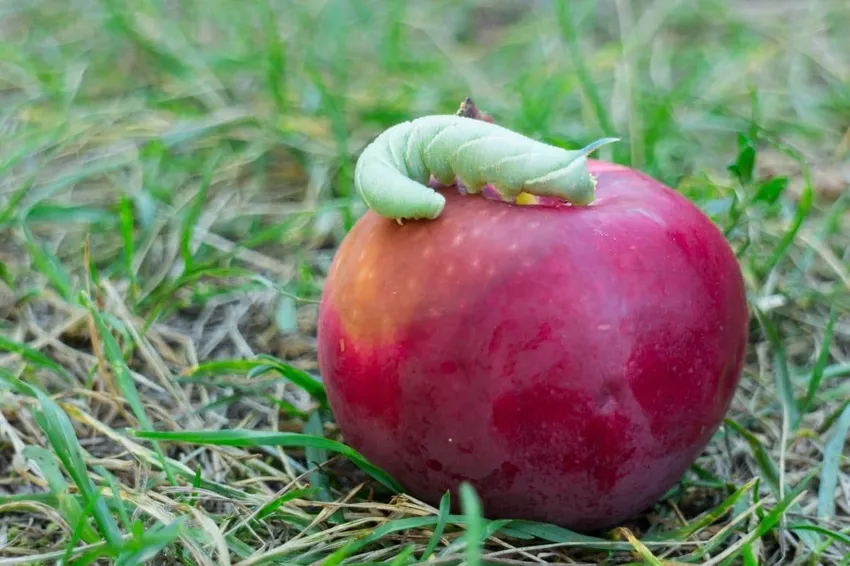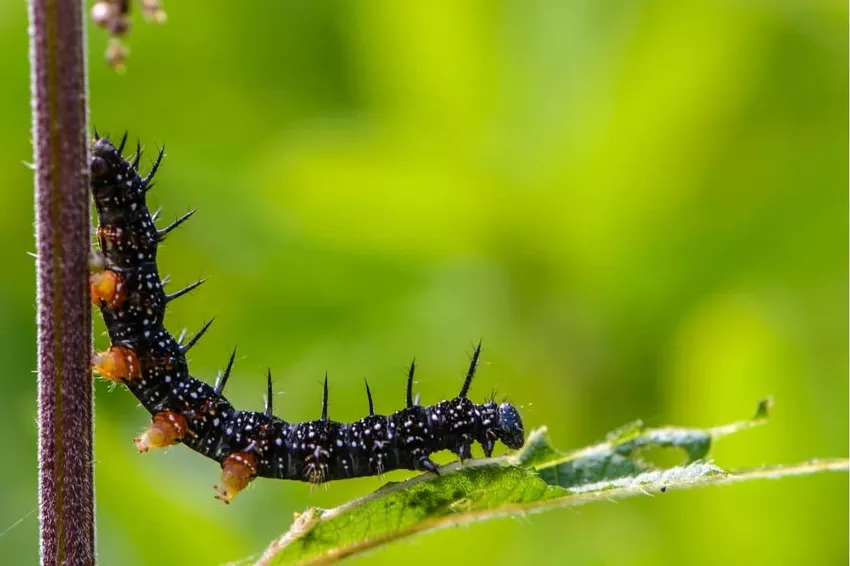
Green, white or brown, with hair, spotted, large or small, the caterpillars appear in flocks in the summer months, especially in July, in the second generation. The following article explains which species are involved.
In a nutshell
- the caterpillars in July are usually the second generation of the year
- Not all caterpillars later become butterflies
- a caterpillar infestation on a plant can be recognized by the small black droppings
- Caterpillars can only be dangerous to their predators, not to humans
- the green caterpillars are very common, but there are also other color variations
Green Caterpillars
The green caterpillars in particular are very widespread and many butterfly species are therefore not so easy to recognize if the color of their caterpillars is almost similar. But there are a few small features by which the different species can still be distinguished. Above all, the popular whereabouts of the voracious caterpillars are a good point of differentiation.
Types from A - J
Evening Peacock (Smerinthus ocellata)
 Source: Simon A. Eugster, Smerinthus ocellatus caterpillar on apple tree, edited by Plantopedia, CC BY 3.0
Source: Simon A. Eugster, Smerinthus ocellatus caterpillar on apple tree, edited by Plantopedia, CC BY 3.0
- green caterpillar
- often changing to bluish or yellowish
- fine white dots all over body
- resembles that of the linden hawk moth
- owns a blue anal horn
- are mostly found on willow trees
Agate Owl (Phlogophora meticulosa)

- also chard owl
- yellow-brown to green
- white line on back
- prefers nettles, lettuce, kitchen herbs and blackberry bushes
gamma-ray owl (Autographa gamma)

- also gun owl
- green, blue or yellowish
- Head drawn in black
- in the middle only two instead of four abdominal feet
- prefers lettuce, kitchen herbs, dandelion and nettle
Types K - Z
Lesser Cabbage White (Pieris rapae)

- dull to light green
- yellowish stripes on back and sides
- white pigment spots
- all types of vegetables and cabbage, rapeseed and nasturtium
Tip: Caterpillars on your kitchen herbs should be fought. Soft soap or tobacco are unsuitable for combating: You still want to enjoy the herbs. A clove of garlic planted in the ground is ideal for keeping pesky animals away.
Linden Hawk-moth (Mimas tiliae)

- green caterpillar
- light green immediately after hatching
- with yellow spot under green horn
- Anal horn is a third as long as body
- diagonal yellow stripes on the sides of the body
- in older animals additional red stripes
- prefers linden trees
Medium vine hawkmoth (Deilephila elpenor)

- green and brown caterpillars
- light black eyespots on the front part
- should keep predators away
- snakes like a snake when threatened
- is often confused with vine hawkmoth caterpillar
- mainly found on fireweed
- pointed anal horn
Different colored caterpillars
Just like the butterflies, their larvae can also have a very colorful appearance. So there are the caterpillars of many different types of butterflies in black, brown or even colorful in July. They are hairy or have a smooth body. There are no limits to the variety here. And as damaging as some larvae can be for the garden, they are still fascinating in terms of their play of colors and appearance.
Types from A - L
Buckthorn blue (Celastrina argiolus)
 adult specimen
adult specimen
- likes to sit on loosestrife
- live in flowers and seeds
- Place sunny and humid
- pale green with vertical stripes in pink
Grass mother hen (Euthrix potatoria)

- also called drinker
- particularly colorful caterpillar
- white tufts of hair on the sides
- usually on stems or blades of grass
- prefers the sun
Pine hawkmoth (Sphinx pinastri)
 Source: Heigeheige, caterpillar Sphinx Pinastri, edited from Plantopedia, CC BY-SA 4.0
Source: Heigeheige, caterpillar Sphinx Pinastri, edited from Plantopedia, CC BY-SA 4.0
- different color variants
- mostly brown
- has a black spike at the end of the body
- prefers to sit on pine trees
Lesser Tortoiseshell (Aglais urticae)

- black with fine white spots
- two yellow lateral lines
- nettle caterpillars
- can be confused with peacock butterfly
- young caterpillars sit in web
- adult animals are solitary
- prefers sunny places
Lesser peacock moth (Saturnia pavonia)

- larvae variable in appearance
- different color after each moult
- warts on the body
- never get the blue color
Map (Araschnia levana)

- black color
- barely perceptible white dots
- two thorns on the head
- heavily branched spines
- nettle caterpillars,
- together without a web
- usually on the underside of the leaf
- adult caterpillars solitary
- prefers shade
- like light forest
Privet hawkmoth (Sphinx ligustri)

- characteristic white-purple and oblique markings
- yellow/black horn
- prefers privet
Notice: Pine, linden and privet hawkmoths develop spikes on their abdomen, the so-called anal horn, which is intended to deter predators. The outgrowth has receded in some species. An eye-shaped elevation remains without danger to humans.
Types of M - Z
Evening primrose hawkmoth (Proserpinus proserpina)
 Source: Philipp M. Moore, Evening primrose hawkmoth caterpillar, edited from Plantopedia, CC BY-SA 3.0
Source: Philipp M. Moore, Evening primrose hawkmoth caterpillar, edited from Plantopedia, CC BY-SA 3.0
- variable drawings
- bright and colorful color variants
- a black eye with an orange border at the end of the body
Gypsy Moth (Lymantria dispar)

- very variable appearance
- beige with black and red spots
- very hairy
- many tufts of hair all over the body
- usually occurs in large populations
Tip: All caterpillars leave tracks on the leaves. The larvae sit not only on the tops of the leaves, but also on the undersides and branches of the plants. The green caterpillars adapt to the environment and are not recognizable at first glance.
Peacock butterfly (Inachia io)

- nettle caterpillar
- form a common thread
- adult caterpillars solitary
- prefers sun
- small white spots on adult caterpillars
- otherwise black body
- up to three generations per year
White-gray lichen bear (Eilema caniola)
 Source: Slimguy, 2022 04 22 Eilema caniola, edited by Plantopedia, CC BY 4.0
Source: Slimguy, 2022 04 22 Eilema caniola, edited by Plantopedia, CC BY 4.0
- yellow ruff and head
- otherwise light brown to grey
- likes to stay in penthouses
- found in large populations in buildings
- preferred food algae and lichens
- occurs more frequently in warm areas
Notice: Be careful with skin contact with these caterpillars, because it can cause allergic reactions and burning of the skin.
frequently asked Questions
What are caterpillars?Caterpillars are the offspring of butterflies and moths. The caterpillars hatch from the laid eggs and feed until they pupate. If they then hatch from the pupation, the finished butterfly or moth unfolds.
Why are caterpillars often so harmful?Here it always depends on the caterpillar species. Some like fresh leaves from trees, vegetables, flowering plants or other growths growing in the garden, while others eat fallen flowers and leaves, thereby cleaning up the environment.
How can I fight caterpillars without harming the butterflies?Nets that you can place over a garden bed or endangered plants are ideal. This prevents butterflies and moths from laying eggs. If an infestation is already evident, the gentlest measure is to collect the caterpillars. Then you can release the animals in the forest, far away from your garden. The caterpillars look for alternative plants for their food intake.
What if my plants are already heavily infested?If bushes or robust plants are already severely damaged by feeding, you can hose them down with water. You should then pick up the larvae that have fallen off the ground and release them elsewhere. Alternatively, you can also put garlic next to the infested plants to drive away the caterpillars.
When and where do green caterpillars appear?The voracious larvae can appear from March to October, depending on the weather and climate even into December. If it is wet and cold in spring, egg laying may be postponed in summer. If it is warm for a long time, the last eggs are not laid until December. No plant in nature is safe from the caterpillars, some species have specialized in certain plants, others choose what is available at the moment.